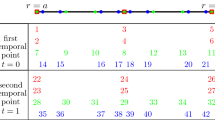Abstract
An algorithm designed for the determination of equilibrium shocks that appear in quasi-static evolution problems associated to elastic nonmonotonous stress-strain laws is presented in the context of one-dimensional media. Two basic procedures are involved in the proposed method: (i) enhancement of the finite element in order to describe the weak discontinuities in any point of its interior and (ii) implementation of a return mapping algorithm for the determination of the shocks, which have to satisfy the inequality constraints imposed by a maximally dissipative hypothesis. A rigorous proof of the unconditional stability property of the algorithm is also given. The present study is applied to the theoretical model presented by Abeyaratne and Knowles in the context of one-dimensional extensional deformations of bars. The numerical results are in complete agreement with the analytical ones.
Similar content being viewed by others
References
R. Abeyaratne, Discontinuous deformation gradients in the finite twisting of an elastic tube. J. Elasticity 11 (1981) 43–80.
R. Abeyaratne, An admissibility condition for equilibrium shocks in finite elasticity. J. Elasticity 13 (1983) 175–184.
R. Abeyaratne and J.K. Knowles, On the dissipative response due to discontinuous strains in bars of unstable elastic material. Int. J. Solids Structures 24 (1988) 1021–1044.
R. Abeyaratne, and J.K. Knowles, Kinetic relations and the propagation of phase boundaries in solids. Arch. Ration. Mech. Analyis 114 (1991) 119–154.
R. Abeyaratne and J.K. Knowles, On the propagation of maximally dissipative phase boundaries in solids. Quarterly of Appl. Mathematics 50 (1992) 149–172.
F. Armero and J.C. Simo, A new unconditionally stable fractional step method for non-linear coupled thermomechanical problems. Int. J. Numer. Meth. Eng. 35 (1992) 737–766.
F. Armero and J.C. Simo, A-priori estimates and unconditionally stable product formula algorithms for nonlinear coupled thermoplasticity. J. of Plasticity (accepted for publication).
I.-W. Chen and P.E. Reyes-Morel, Implications of transformation plasticity in ZrO2-containing ceramics. I. Shear and dilatation effects. J. Am. Ceram. Soc. 69 (1986) 181–189.
T.W. Duering, K.N. Melton, D. Stöckel and C.M. Wayman, Engineering Aspects of Shape Memory Alloys. Butterworth-Heinemann (1990).
J.L. Ericksen, Equilibrium of bars. J. Elasticity 5 (1975) 191–201.
J.D. Eshelby, The elastic energy-momentum tensor, J. Elasticity 5 (1975) 321–335.
M.E. Gurtin, Two-phase deformations of elastic solids. Arch. Ration. Mech. Analysis 84 (1983) 1–29.
E. Hairer and G. Wanner, Solving Ordinary Differential Equations II—Stiff and Differential-Algebraic Problems. Springer-Verlag (1991).
R. Hill, Acceleration waves in solids. J. Mech. Phys. Solids 16 (1962) 1–10.
R.D. James, Co-existent phases in one dimensional theory of elastic bars. Arch. Ration. Mech. Analysis 72 (1979) 99–140.
J.K. Knowles, On the dissipation associated with equilibrium shocks in finite elasticity. J. Elasticity 9 (1979) 131–158.
C.T. Liu, M. Wutting, K. Otsuka and H. Kunsmann (eds), Shape-Memory Materials and Phenomena—Fundamental Aspects and Applications. Materials Research Society (1992).
J. Mandel, Conditions de Stabilité et Postulat de Drucker. In J. Kravtchenko and P.M. Sirieys (eds), Rheology and Soil Mechanics. IUTAM Symposium Grenoble 1964 (1966) pp. 58–68.
R.M. McMeeking and A.G. Evans, Mechanics of transformation-toughening in brittle materials. J. Am. Ceram. Soc. 65 (1983) 242–246.
D.L. Porter, A.G. Evans and A.H. Heuer, Transformation-toughening in partially-stabilized Zirconia (PSZ). Acta Metallurgica 27 (1979) 1649–1654.
B.D. Reddy and J.C. Simo, Stability and convergence of a class of enhanced strain methods. Pre-print, Stanford University (1992).
S.A. Silling, Consequences of the Maxwell relation for anti-plane shear deformations of an elastic solid. J. Elasticity 19 (1988) 241–284.
S.A. Silling, Phase changes induced by deformation in isothermal elastic crystals. J. Mech. Phys. Solids 37 (1989) 293–316.
J.C. Simo, Algorithms for static and dynamic multiplicative plasticity that preserve the classical return mapping schemes of the infinitesimal theory. Comput. Meth. Appl. Mech. Eng. 99 (1992) 61–112.
J.C. Simo and F. Armero, Unconditional stability and long-term behavior of transient algorithms for the incompressible Navier-Stokes and Euler equations. Comput. Meth. Appl. Mech. Eng. (accepted for publication).
J.C. Simo and T.J.R. Hughes, On the variational foundations of assumed strain methods. J. Appl. Mech. 53 (1986) 51–54.
J.C. Simo and M.S. Rifai, A class of mixed assumed strain methods and the method of incompatible modes. Int. J. Numer. Meth. Eng. 29 (1990) 1595–1638.
J.C. Simo and R.L. Taylor, Consistent tangent operator for rate-independent elastoplasticity. Comput. Meth. Appl. Mech. Eng. 48 (1985) 111–131.
J.C. Simo and R.L. Taylor, A return mapping algorithm for plane stress elastoplasticity. Int. J. Numer. Meth. Eng. 22 (1986) 649–670.
T.Y. Thomas, Plastic Flow and Fracture in Solids. New York: Academic Press (1961).
Author information
Authors and Affiliations
Additional information
Pontifícia Universidade Católica do Rio de Janeiro
Visiting Professor at Stanford University during the development of this work.
Rights and permissions
About this article
Cite this article
Mamiya, E.N., Simo, J.C. Numerical simulation of equilibrium shocks in maximally dissipative elastic systems. Part I: The one-dimensional case. J Elasticity 35, 175–211 (1994). https://doi.org/10.1007/BF00115542
Received:
Issue Date:
DOI: https://doi.org/10.1007/BF00115542



